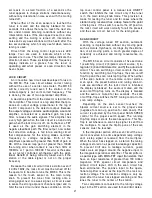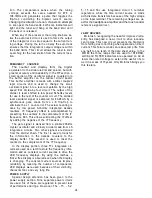
Technical Description
Engineering direction dictated a tuner design
governed by insistence on great flexibility and ease
of use. This had to be done while designing an RF
section with great sensitivity and the world's best
selectivity in keeping with the needs of low distor-
tion. These values were achieved and they retain the
Mclntosh reputation of outstanding performance,
long life and reliability.
RF-IF SECTION
In the ANT SWITCH six RF PIN diodes are con-
nected as a single pole double throw switch. This
allows the use of two antennas or the use of an
antenna and a cable. Input to output isolation of this
switch is greater than 75dB.
Following the ANT SWITCH is an RF tuner of ex-
ceptional performance. This performance is achiev-
ed by the use of a low noise junction FET and a high
power bipolar transistor (a heatsink is used) con-
nected as a cascode amplifier. This connection
allows high gain, low noise, and high output levels
without the need for neutralization. Two additional
PIN diodes are used to insert a second tuned anten-
na Preselector circuit during strong signal recep-
tion. For lower intermodulation distortion the tuned
circuits are tuned by a series parallel connection of
four matched varactor diodes. This circuit and the
high tuning voltage (5-26 volts) eliminates the RF in-
termodulation distortion caused by diode non-
linearities.
A f t e r the RF amplifier two parallel tuned circuits
are used to provide the proper load impedance for
the bipolar transistor. The use of two tuned circuits
at this location greatly improves the image rejection
and overload performance of the tuner, as well as in-
creasing the RF selectivity.
The following balanced mixer is a matched dual
J-FET and bipolar transistor circuit. A low loss
toroidal phase splitting transformer is used as an
impedance matching network in the gate circuit of
the mixer. At the output a balanced double tuned
transformer is used as the drain load. This arrange-
ment gives great immunity to mixer overload in the
presence of a very strong signal. A bipolar transistor
is used as an oscillator buffer to prevent oscillator
pulling on strong signals, and as the constant cur-
rent source for the dual J-FET mixer.
The MR 80 has the narrowest IF bandwidth ever
used in a stereo tuner. It is the correct width to let
just one FM station through. The excellent selectivi-
ty of the MR 80 (210kHz wide at 60dB down) permits
tuning to stations that are impossible to receive on
ordinary tuners.
Constant delay design techniques are used in the
4-pole 4-zero crystal filter used in the SUPER NAR-
ROW position. However, due to the extreme selec-
tivity, delay distortion is very slightly increased over
the NARROW selectivity position.
Four differential amplifiers, coupled with PHASE-
LINEAR monolithic filters, comprise the NARROW
selectivity and signal strength sections of the IF
amplifier. One half of each differential amplifier out-
put drives a filter and the second output drives a f u l l
wave rectifier circuit. The outputs of these four
rectifier circuits are summed at the inverting input of
an operational amplifier. A f i f t h rectifier circuit that
is driven from the limiter is also summed at the input
to the operational amplifier. The output of the opera-
tional amplifier is a voltage that is proportional to
the log of the RF input level. Dynamic range is from
2
m
V to over 2V, that is, greater than 120dB. A solid
state signal strength meter is used as a front panel
indication of the incoming RF signal level. Twelve
LED's are used in place of the conventional meter
movement. The LED's have an almost unlimited life.
The fast response of the LED's plainly shows
multipath signals and antenna misorientation. To
better use the wide dynamic range of the five signal
strength detectors, an adjustment is provided to
reduce the full scale signal from 100,000
m
V to any
value below that. This meter can be set to give a full
scale indication on a signal as low as 2
m
V. This
allows setting the signal meter to indicate full scale
on the strongest station in the users area. Then the
signal strength meter indicates the RF level of all
stations received relative to the strongest in the
listener's area.
The signal strength voltage is also used to control
mono/stereo switching, stereo f i l t e r insertion,
muting, and automatic scan stop. Because of it's
wide range and high repeatability this control
voltage is also used to adjust the stereo separation
at low RF signal levels. This produces the maximum
signal to noise ratio possible for all signal levels.
Following the selectivity section of the IF ampli-
fier is the LIMITER. A total gain of 80dB is used in
this circuit. The use of very high gain in the limiter
circuit produces hard limiting with very good im-
pulse noise rejection. Limiter bandwidth is greater
than 50MHz, producing excellent detector capture
characteristics.
A broadband Foster-Seeley discriminator is used
as the detector. This detector coupled with the
broadband limiter produces unmeasurable noise
and distortion. A high speed buffer amplifier follow-
ing the detector isolates the detector from all varia-
14
Summary of Contents for MR80
Page 1: ...Reading Time 32 Minutes Price 2 00 THE MclNTOSH MR 80 DIGITAL FM TUNER...
Page 10: ...Performance Charts SIGNALINPUT 10 SIGNAL INPUT...
Page 11: ...11 FREQUENCY IN HERTZ FREQUENCY IN HERTZ FREQUENCY IN HERTZ...
Page 12: ...12 FREQUENCY IN HERTZ FREQUENCY IN HERTZ FREQUENCY IN HERTZ...
Page 13: ...13 FREQUENCY IN HERTZ FREQUENCY IN HERTZ FREQUENCY IN HERTZ...
Page 19: ...19...
Page 20: ...Block Diagram 20 MclNTOSH MR 80...
Page 21: ...DIGITAL FM TUNER 21...






































